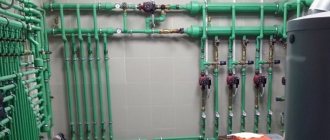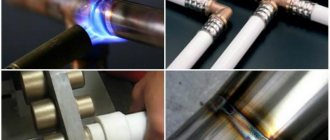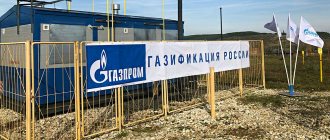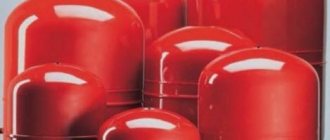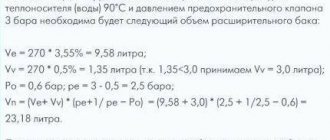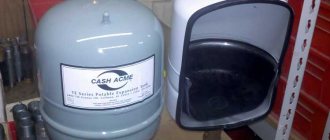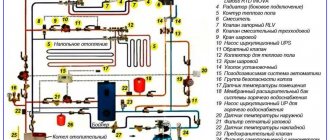The design for heating a private house works based on the use of an expansion tank. It is in this part of the entire structure that the coolant is located. The main function of the expansion tank is to compensate for expansion from heat, depending on the specific operating mode of the equipment.
Closed heating in a private house
A closed heating system is more often used in private homes. For its correct operation, constant human control is not required - it operates automatically. In addition, any type of coolant can be used here (even antifreeze can be used). This system maintains a stable pressure level and the coolant does not interact with air.
The expansion tank can be installed anywhere - it is advisable to mount it next to the boiler. If we are talking about a wall-mounted model, then expansion tanks are immediately installed in them. Automatic air vents are also installed in closed models.
A closed heating system consists of the following main elements:
- Boiler and security group. A safety group can be immediately built into the boiler - this is typical for wall-mounted gas models, pellet variations, as well as gas generator models.
- Radiators and pipes (sometimes this also includes convectors and water heated floors).
- A circulation pump, which helps the coolant move through the system. It is placed on the return pipeline (lower temperature here).
- An expansion tank that stabilizes pressure and also compensates for the volume of coolant.
Classification of heating systems
To properly fill a water heating system.
you need to know what type it is. There is a classification of systems according to the method of pipe routing: from the top, from the bottom, horizontal, vertical or combined. According to the method of connecting devices using pipes, systems are divided into: single-pipe and double-pipe. Also, water can circulate in the system naturally or forcefully (if a pump is used). Based on the scale of operation, local and central heating systems are distinguished. As the water moves in the pipes, there are dead-end and passing pipes. All these types are used in mixed order in everyday life.
Conclusions and useful video on the topic
This video material presents an example of a detailed hydraulic calculation of a 2-pipe closed-type heating system for a 2-story house in the VALTEC.PRG program:
Here is a detailed description of the design of a single-pipe heating system:
It is possible to install a closed version of the heating system yourself, but you cannot do it without consulting specialists. The key to success is a properly completed project and quality materials.
Do you have any questions about the specifics of a closed heating circuit? Is there information on the topic that would be of interest to site visitors and us? Please write comments in the block below.
Water or coolant, select the optimal filling system
Antifreeze for heating system
The optimal composition of the liquid should be determined by the parameters of the heating system. Often the heating system is filled with water, as it has a number of significant advantages. The determining factor is the affordable cost - they often use simple tap water. However, this is fundamentally wrong. A large number of metal elements and alkali will contribute to the formation of build-up on the inner walls of pipes and radiators. This leads to a decrease in the bore diameter and an increase in hydraulic losses in certain sections of the pipeline.
But how to properly fill a closed heating system with water to avoid such troubles? Experts recommend using distilled water. It is maximally purified from impurities, which has a positive effect on its physical and operational properties.
Energy intensity. Water accumulates heat well in order to subsequently transfer it to the room; Minimum viscosity index
This is important for closed heating systems with forced circulation and affects the power of the centrifugal pump; As the pressure in the pipes increases, the boiling point shifts upward. Those
in fact, the process of transition from liquid to gaseous state occurs at a temperature of 110°C. This makes it possible to use high-temperature heating modes.
But if there is a possibility of exposure to negative temperatures, then water as a liquid for filling heating systems is unacceptable. In this case, you should use antifreezes with a crystallization threshold significantly lower than 0°C. The best option is solutions of propylene glycol or glycerin with special additives. They belong to the class of harmless substances and are used in the food industry. Solutions based on ethylene glycol have the best technical qualities. Until recently, they were used to fill closed heating systems. However, they are extremely harmful to humans. Therefore, despite all their positive qualities, the use of ethylene glycol-based antifreeze is not recommended.
But what can you fill the heating system with - water or antifreeze? If there is no chance of exposure to low temperatures, water is the best choice. Otherwise, it is recommended to use special coolant solutions.
Automotive antifreeze cannot be poured into the heating system. This will not only lead to boiler breakdown and failure of radiators, but will also be hazardous to health.
Main types of coolants
Heating system.
The operating principle of the heating system is that the coolant moves from the heat source to the end point through pipes, heating them. The type and design of the heating equipment determines the type of coolant used, which can be liquids and gases.
The most popular liquid coolants are:
- Water is the most accessible and cheapest resource. According to statistics, about 70% of heating systems use water, which has a high density and heat capacity. In addition, this type of coolant has gained such popularity due to its properties, such as low viscosity, high heat transfer coefficient, and easy temperature control. The main disadvantage is the ability to freeze at zero temperatures. If water freezes in the heating system, this will lead to rupture of pipes and failure of all equipment.
- Antifreeze - this type of coolant is not as widespread as water, and its use is 5%. It is used for heating administrative buildings and residential buildings where the heating system does not allow the use of water due to the increased risk of corrosion. The main advantage of antifreeze is freezing in frosts of 60 - 70 degrees.
The following gases are used as coolant:
- Water vapor is mainly used in industrial buildings, since its use is prohibited in residential and public buildings. Water vapor maintains the temperature of heating devices at 100 degrees; according to sanitary standards, this figure should not exceed 80 degrees.
- Flue gases are toxic, so recently they have been used only for heating water and in order to save electricity to produce a heat source.
- Air is characterized by low heat capacity, so moving it through the heating system requires large energy costs. It is most cost-effective to use air as a coolant, provided that it simultaneously performs two functions: heating and ventilation.
Currently, organic liquids are being introduced as a coolant, which have excellent freezing properties and low viscosity. However, they have not yet become widespread due to their high cost and scarcity.
Marking of sealed bearings
Let's take a closer look at ISO standards. The suffix Z denotes the presence of one protective washer made of steel. 2 Z or ZZ indicates that the product is protected by metal seals on both sides.
The RS designation states that the assembly is partially enclosed by a plastic collar. If the code contains the abbreviation 2 RS, then the separator is completely covered. The numeric or alphabetic additional positioning that follows describes the material of which the cover is made. The following options are possible: RS 1; RS 2; RS 1Z; RSH; RSL. The most common standard type is nitrile butadiene rubber. It is resistant to oil products, animal and vegetable fats, moisture and steam.
Pressing the heating system
Pressing the heating system
Before filling the heating system with coolant, it is necessary to check the tightness of all joints and connections. To do this, pressing is performed - creating excess pressure in the pipes, i.e. a situation of destabilization of the system is artificially created.
This can be done in two ways - using air injection or coolant. This must be done before the heating system of the double-circuit boiler is filled. This procedure can be carried out using a mechanical (electric) pump or by connecting the water supply. The last option is not recommended, since it will be very difficult to control the process. The order of execution is as follows:
- Preliminary visual inspection of joints and connecting nodes;
- Connecting the mechanism to the inlet pipe of the system;
- Creation of excess pressure, the value of which should exceed the norm by 1.5 times.
The condition of the heating elements must be checked. If a leak occurs, the process stops immediately and can only begin when the defect is repaired.
The process of starting an open gravity heating system
In modern houses, open heating systems are quite rare; such technologies have long been considered a relic of the past. But they still exist, so you should consider how they need to be filled with water. In any such heating system there is an expansion tank at its highest point; it is designed to accumulate water after increasing its volume in the system with increased pressure during rising temperatures. The tank is an open container with or without a lid. The system is filled with water through the tank. Large volumes of liquid, of course, will be quite problematic to fill in small containers, especially at the highest point.
It would be most rational to use a regular household vibration pump. To do this, prepare a capacious container and fill it with water. Pre-prepared hoses are attached to the pump with clamps. This pump has a submersible type of structure. The hose through which water will be drawn must be lowered into a prepared tank of water. The hose from which the water will be released is immersed in the expansion tank. Turn on the pump, the pressure in the system should be from one and a half to two atmospheres. When lowering, add water to the prepared tank and lower the hose into it. When the heating complex is filled, water will be visible at the bottom of the expansion tank, the system can be considered full.
Installation diagram of a water heating system.
Excess air will come out of the pipes during the first fire through the expander. It should be noted that during the heating season, when the system maintains a constantly high temperature, water will gradually evaporate from the expander. It is necessary to recharge by adding water to the expander to the required level. You should also monitor the temperature on a thermometer attached to the heating boiler. When its level reaches above 80°C, the water will soon begin to boil and splash out. In this case, it is necessary to block the access of oxygen to the firebox to reduce the intensity of combustion.
Tank selection criteria
Expansion tanks are made of steel. Inside there is a membrane dividing the container into 2 compartments. The first is filled with gas, and the second with coolant. When the temperature rises and water rushes from the system into the tank, the gas is compressed under its pressure. The coolant cannot occupy the entire volume due to the presence of gas in the tank.
The capacity of expansion tanks varies. This parameter is selected so that when the pressure in the system reaches its peak, the water does not rise above the set level. To protect the tank from overflow, a safety valve is included in the design. Normal tank filling is from 60 to 30%.
The optimal solution is to install the expansion tank in a place where there are the fewest bends in the system. The best place for it is a straight section in front of the pump.
Filling the system from below
So, let's get back to pumping fluid into the system. We use a container of suitable volume (a 200-liter plastic barrel works well). We lower a pump into it, creating the pressure required for pumping liquid no higher than 1.5 atm (typical value in the range of 1-1.2 atm). Such pressure requires the pump to create a pressure of 15 m (for the submersible “Malysh” it reaches 40 m).
Having filled the barrel with water, we start the pump, monitoring the liquid level, which should be located above its inlet pipe to prevent “airing”. The level drops - add water. Antifreeze should be pumped from a smaller container (bucket) so as not to immerse the submersible pump housing in the liquid (and then wash it) - just immerse the inlet pipe. You will have to add antifreeze frequently, turning off the pump periodically.
Filling the system is carried out with Mayevsky taps open on installed heating radiators with substitute containers for collecting water. When liquid comes out of all air vents, close the taps and continue the injection process.
We control the pressure using a pressure gauge (a boiler gauge will do). When its value exceeds the hydrostatic pressure, equal to the pressure in the liquid column height from the bottom to the top point of the system (a height of 5 m gives a static pressure of 0.5 atm), we continue to fill the system, monitoring with a pressure gauge the moment the pressure reaches the required value.
Pumping antifreeze with the “Malysh” pump.
Having filled the system, turn off the pump, open the air valves (the pressure will inevitably drop), and then pump up the water. We repeat the process several times, displacing air bubbles.
We complete the filling by inspecting the system for leaks. After the pump is turned off, the liquid in the hose connected to the outlet pipe is under pressure. If antifreeze was pumped in, first disconnect the hose from the pump inlet pipe and drain the liquid into a container, being careful not to drench the mechanism body.
Security group
A safety group is placed on the supply pipeline at the outlet of the boiler. She must control its operation and system parameters. Consists of a pressure gauge, automatic air vent and safety valve.
The boiler safety group is placed on the supply pipeline before the first branch
The pressure gauge makes it possible to control the pressure in the system. According to recommendations, it should be in the range of 1.5-3 Bar (in one-story houses it is 1.5-2 Bar, in two-story houses it is up to 3 Bar). If you deviate from these parameters, appropriate measures must be taken. If the pressure drops below normal, you need to check if there are any leaks, and then add some coolant to the system. At increased pressure, everything is somewhat more complicated: it is necessary to check in what mode the boiler is operating, whether it has overheated the coolant. The operation of the circulation pump, the correct operation of the pressure gauge and the safety valve are also checked. It is he who must discharge excess coolant when the threshold pressure value is exceeded. A pipe/hose is connected to the free branch pipe of the safety valve, which is discharged into the sewer or drainage system. Here it is better to do it in such a way that it is possible to control whether the valve works - if water is discharged frequently, you need to look for the reasons and eliminate them.
Security group composition
The third element of the group is an automatic air vent. Air trapped in the system is removed through it. A very convenient device that allows you to get rid of the problem of air locks in the system.
Security groups are sold assembled (pictured above), or you can buy all the devices separately and connect them using the same pipes that were used to wire the system.
Types of closed heating system diagrams
The main advantage of natural circulation schemes is their independence from the availability of electricity, but they have a limitation: the length of the circuit must be no more than 30 meters, otherwise the system will be inoperable. There is one more nuance - with natural circulation, even in a closed system, you need to install a drain valve at the top point, with the help of which you can remove air that has entered, for example, when adding coolant.
System with natural circulation of a one-story house. Single-pipe circuit, top wiring
In a forced circulation circuit, pressure is created by a circulation pump. Some boilers have it built in, some don't. Some long circuits require the installation of two pumps. Then it is not necessary to observe slopes; the most important thing is not to make the sections slope in the other direction, which will negatively affect the performance of the heating and may even require rework.
On the one hand, the use of circulation pumps is a disadvantage, since its performance depends on the availability of electricity, but on the other hand, it is a big plus:
- allows you to use pipes of a smaller cross-section and radiators of a smaller volume, which means you spend less money on purchasing materials;
- increase the speed of movement of the coolant, and therefore reduce its inertia and increase the level of comfort;
- less coolant, less fuel is wasted on heating it - money is saved.
Reduced volumes of pipes and radiators mean a decrease in the volume of the system, which again makes it possible to reduce the heating inertia of the coolant - it heats up faster, and the heating is more efficient. A smaller volume of coolant means a smaller volume of the expansion tank, and there is no need to look for a place to install it. Modern boilers have built-in membrane tanks (for example, wall-mounted gas boilers), and the heating efficiency using them is very high due to the fact that a powerful pump is installed (it is also built-in).
It is better to connect the pump with a bypass - to be able to repair/replace it without destroying the system
When choosing a pump, remember that there is a direct relationship between its power and heating efficiency. Therefore, choose one that is low noise, powerful and reliable.
It is worth noting that it is easy to make a closed one from an open system - you just need to change the expansion tank - install a membrane type and the system will be operational. To make it more efficient, you will need to install a pump. Moreover, modern pumps can be installed in both supply and return. Previously, they were installed on the return line because the coolant temperatures there are lower. But modern pumps use heat-resistant materials; the temperatures of heating systems are not so critical for them
Just when buying, pay attention to the operating temperature range, or put it in the return line - only so that it “presses” into the boiler. In this case, the pump power may be small, since open systems use larger pipe diameters than closed ones, and the hydraulic resistance of the system is small
There are many nuances and features in heating a private home, and it’s not easy to figure it out. But once you set a goal, you can do everything yourself - create a workable good project, select the right equipment and install everything yourself. And closed systems in this sense are no exception.
Boiler - which one to choose
Since the closed heating system of a private house can operate autonomously, it makes sense to install a heating boiler with automation. In this case, you do not need to return to it after configuring the settings. All modes are supported without human intervention.
Gas boilers are the most convenient in this regard. They have the ability to connect a room thermostat. The temperature set on it is maintained to the nearest degree. It dropped by a degree, the boiler turned on, heating the house. As soon as the thermostat is activated (temperature reached), operation stops. Comfortable, convenient, economical.
Some models have the ability to connect weather-dependent automation - these are external sensors. According to their readings, the boiler regulates the power of the burners. Gas boilers in closed heating systems are good equipment that can provide comfort. The only pity is that gas is not available everywhere.
Two-pipe closed heating system in a house on two floors (diagram)
Electric boilers can provide a no less degree of automation. In addition to traditional units, induction and electrode units have recently appeared on heating elements. They are distinguished by their compact size and low inertia. Many believe that they are more economical than boilers using heating elements. But even this type of heating unit cannot be used everywhere, since power outages in winter are a common occurrence in many regions of our country. And provide the boiler with electricity. 8-12 kW from the generator is a very difficult matter.
Solid or liquid fuel boilers are more versatile and independent in this regard. An important point: to install a liquid fuel boiler, a separate room is required - this is a requirement of the fire service. Solid fuel boilers can be installed in the house, but this is inconvenient, since a lot of debris falls from the fuel during combustion.
Modern solid fuel boilers, although they remain periodic equipment (they warm up during combustion and cool down when the fuel burns out), but they also have automation that allows you to maintain a given temperature in the system, regulating the intensity of combustion. Although the degree of automation is not as high as that of gas or electric boilers, it is there.
Example of a closed heating system with an induction boiler
Pellet boilers are not very common in our country. In fact, this is also solid fuel, but this type of boiler operates continuously. Pellets are automatically fed into the stove (until the stock in the hopper runs out). If the fuel quality is good, ash removal is required every few weeks, and all operating parameters are controlled automatically. The only thing that prevents the spread of this equipment is its high price: manufacturers are mainly European, and their prices are appropriate.
A little about calculating boiler power for closed-type heating systems. It is determined according to the general principle: per 10 sq. square meters with normal insulation will require 1 kW of boiler power. It’s just not recommended to take it end-to-end. First, there are unusually cold periods when you may not have enough rated power. Secondly, working at the power limit leads to rapid wear of the equipment. Therefore, it is advisable to take the boiler power for the system with a margin of 30-50%.
Filling technology where to supply coolant
The necessary means are a container and a pump that creates the required pressure of the coolant liquid. Submersible type “Gnome” or “Kid” are quite suitable (popular with gardeners who use them for watering areas located above the levels of reservoirs). There is evidence of successful filling of closed systems using hand pumps - from those used for spraying protective solutions on garden crops, to specialized hand pumps used for pumping motor fuels or liquid chemicals from drums. Any heating circuit can be successfully filled by monitoring the pressure using a pressure gauge.
Filling the system with antifreeze using a submersible vibration pump.
The first step is to select the fluid entry point. If the pressure created by the pump raises the liquid to the top of the system, it should be connected at the lowest point of the boiler room - the coolant make-up pipe, cut into the “return” in front of the boiler. In addition to the make-up inlet, a structurally separate drain outlet is required (two different system components). The first is equipped with a valve (ball valve) and a check valve, the second - only with a valve (ball valve). If the lowest point of the system is the water drain fitting from the boiler, then you can drain/fill the system with water through it. Since a check valve is not installed behind the boiler drain (behind the drain at all), any shutdown of the pump will cause the pumped liquid to leak out - you need to quickly turn off the tap in front of the fitting.
Design of a typical drain/recharge unit.
When filling with coolant
There are only two known situations that require this technological operation:
- putting heating into operation (at the beginning of the heating season);
- restart after repair work.
Typically, coolant water is drained in late spring for two reasons:
- Water inevitably becomes contaminated with corrosion products (inside radiators, metal-plastic and polypropylene pipes are not susceptible to it). If you leave old water for the new season, you risk breaking the circulation pump with solid contaminants.
- Flooded systems in country houses that have not been started can “defrost” during a sudden cold snap - such cases are not uncommon. In this sense, antifreeze coolant is preferable. The high-quality composition has high anti-corrosion properties, increasing the drain interval to 5-6 years. There are known cases of uninterrupted heating operation with the same volume of antifreeze for 15-17 years. It is recommended to drain low-quality antifreeze after 2-3 years.
Pumping antifreeze into the heating system.
Features of starting a closed heating system with distilled water
Filling a closed heating system with water has the following features:
It will be much easier to provide the heating circuit with the necessary pressure if the living space has access to a central water supply. In this situation, to pressurize the heating system, it is enough to fill it with water through a jumper that removes the water supply, while carefully monitoring the increase in pressure on the pressure gauge. After completing such an event, unnecessary water can be removed using any of the valves or by means of an air vent.
Many people wonder whether special preparation of water for the heating system should be carried out or whether it is possible to limit it to water from the nearest body of water. At the same time, some argue that distilled water in the heating system will have a beneficial effect on the service life of the equipment and will not allow it to fail prematurely. But it is much more important to understand how to prepare water for heating if a special non-freezing liquid like ethylene glycol is added to it and how to subsequently fill the heating circuit with such coolant.
For these purposes, it is customary to use a special pump that serves to fill the system with water, and it can be controlled either automatically or manually. This pump is connected using a valve, and after ensuring the required pressure, the valve is closed. There are situations when such equipment is not at hand. As an option, it is possible to connect a standard garden hose to the discharge valve, the second end of which should be raised to a height of 15 meters and the circuit should be filled with water using a funnel. This method will be especially relevant if there are tall trees near the building being developed.
Another option for filling the heating system is to use an expansion tank, which performs the function of containing excess coolant caused by its expansion during the heating process.
Such a tank looks like a reservoir, which is divided in half by a special membrane made of elastic rubber. One part of the container is intended for water, and the other for air. The design of any expansion tank also includes a nipple, with which it becomes possible to establish the required pressure inside the unit by removing excess air. If the pressure is insufficient, then this parameter can be compensated by pumping air into the system using usually a bicycle pump.
The whole process is not particularly difficult:
First, air is eliminated from the expansion tank, for which you need to unscrew the nipple. Ready-made tanks go on sale with slightly excess pressure, which is equal to 1.5 atmospheres; then the heating circuit is filled with water. In this case, the expansion tank must be mounted so that it is positioned with the thread upwards
It is important to remember that it is not advisable to fill the tank completely with water. It would be more correct if the total volume of air in this device is approximately one tenth of the total volume of water, otherwise the tank will not cope with its main function and will not be able to accommodate excess heated coolant; after this, air is pumped into the system through the nipple, which, as mentioned above, can be done using a regular bicycle pump
The pressure must be monitored using a pressure gauge.
All of these actions will allow you to carefully fill the heating system with water and ensure stable and high-quality operation of the entire circuit. If necessary, you can always turn to specialists for help, who always have in stock various photos of devices necessary for such work that can help with connection.
Filling the heating system with water in the video:
How to open a sealed bearing with an iron boot for lubrication
The metal ring is held in the holder due to elasticity. In order to get to the balls, you need to hook and pull out with a sharp object (knife blade, special grip or awl). With this method, you should be careful not to damage the device. Otherwise, it will be impossible to put it in place in the future.
Next, we perform the same operation on the other side. After this, remove the old filler using a solvent (diesel fuel, gasoline, kerosene). Dry it. We carry out diagnostics for suitability according to the algorithm described above and begin assembly.
Install one protective ring. We place new oil in the space. We scroll several times so that it is distributed throughout the entire volume. Remove the excess and close with a second lid. There are models where the safety device is fixed with a metal stopper. Then you need to remove and install this part.
Closed heating system. How to fill with water correctly
Nowadays, many owners of apartments and private houses choose closed heating systems. A closed system is a circuit within which the movement of the coolant is carried out using the movement of the coolant - a pump, that is, forced. A special feature is a membrane-type expansion tank. Essential elements. boiler, tank - membrane, radiators, pump, pipes, also fittings, fasteners and filtering equipment. But very often, buyers of such “closed heating” soon wonder how to fill it and how to close the heating pipes. Below we will tell you how to properly fill a closed heating system with water.
The heating system is filled through the boiler power supply. This is done using an electric pump, as well as a manual crimping machine. The system is filled with prepared network water or antifreeze made using a special method - it is a non-freezing coolant. At this time, air is released throughout the entire internal part of the system (faucets, radiators, vents, etc.). When the required pressure has been achieved, the system can be put into operation. Sometimes there are difficulties in creating ideal pressure. Closing the heating pipes will largely depend on individual wishes, the design solution of the room and the location of the pipes themselves in the apartment, their number and size.
Difficulties often arise when filling with water. If the system is closed, then the expansion membrane tank (pressure inside the tank up to 6 bar) and the safety valve up to 3 bar must also be closed. Special valves must be installed to bleed air in accumulation areas, as well as a valve for feeding and filling pipes and heating equipment. The sequence of actions when filling a closed system is as follows:
Unscrew the screw located on the pump. Use a screwdriver to unscrew the pump system shaft. Tighten the screw tightly. Open the make-up screw. Fill the system until the pressure reaches approximately 0.5 bar. (you can start from 0.3 bar). Be sure to check if there are any leaks during this procedure! Raise the operating pressure in the system to 2 bar. Make sure that there are no leaks anywhere. Bleed the air in absolutely all internal places of the system. The next step is to increase the pressure in the system to about one and a half bar. This will be the most optimal pressure for a closed heating system. If the system undergoes cooling or heating, then the fluctuations should not be significant (from 0.1 bar to 0.5 bar). Watch the range of fluctuations! Sudden changes threaten to break all equipment, pipes and fittings!
There is no water level in such closed systems. The presence or absence of water is controlled using pressure. At normal levels, it should be between one and two bars.
A closed heating system is easy to operate, less susceptible to corrosion and destruction, and is easy to replenish and, if necessary, drain. If you have any questions or find malfunctions in the operation of the heating system (freezing, leaking, etc.), then immediately contact support!
Heating boilers are one of the main types of heating equipment and are devices for heating the coolants entering the heating system to a certain temperature. The coolant passes through a closed circle of the heating system.
Before you start looking for contractors to improve your own balcony, answer yourself one question: what do I want to get as a result of glazing? Perhaps you just want to use this room for drying.
Such cast iron radiators, which are familiar to the majority of the population and were installed many years ago, can no longer fully cope with the functions assigned to them for heating rooms and have a rather unattractive appearance.
Solid fuel heating boilers are devices that heat a room using solid fuels (for example, wood, coke, briquettes or coal). Typically, such boilers are universal, as they can work on anyone.
Components and their purpose
Composition of a closed heating system
In general, a closed heating system consists of a certain set of elements:
- Boiler with safety group. There are two options here. The first is that the safety group is built into the boiler (gas wall-mounted boilers, pellet boilers and some solid fuel gas generators). The second is that there is no safety group in the boiler, then it is installed at the outlet in the supply pipeline.
- Pipes, radiators, water heated floors, convectors.
- Circulation pump. Ensures the movement of coolant. It is installed mainly on the return pipeline (the temperature is lower here and there are fewer possibilities of overheating).
- Expansion tank. Compensates for changes in coolant volume, maintaining stable pressure.
Now in more detail about each element.
What to do if the pressure in the system drops and increases
If you notice a decrease in pressure, the first thing you need to do is turn off the pump. And then act based on the pressure gauge readings:
- If the static pressure also drops, there is a leak somewhere. It is necessary to inspect all the elements and eliminate it. Please note that even a very small hole (less than a millimeter) can be the cause, so it can be difficult to find the damage. If the pipeline is long, you can localize the leak area by disconnecting the branches one by one. As soon as the fall has stopped, the area is determined - depressurization on the one that was just turned off.
- If the pressure is stable when the pump is turned off, the pump has failed and needs to be repaired or replaced.
An increase in pressure is observed less frequently, but it also happens. It is usually caused by an increase in temperature in the system, and it rises due to insufficient coolant circulation. But why the coolant circulates poorly needs to be understood.
- First, we check the functionality of the pump. Let's turn it off and watch. If the pressure continues to rise, the problem is not with the pump. If it stabilizes, it’s his fault.
- We clean filters and dirt traps.
- If the pressure still rises, an air lock may have formed - bleed the air in the system.
- If this does not help, we check the condition of the shut-off valves - maybe someone accidentally or intentionally closed it, blocking the flow of coolant.
- Another reason is that due to a breakdown or failure of the automation system, the system is under constant recharge.
Using this algorithm, you can independently determine the cause of the abnormal condition of the heating system and eliminate it.

